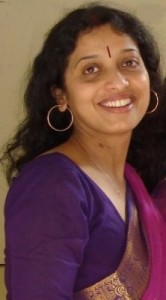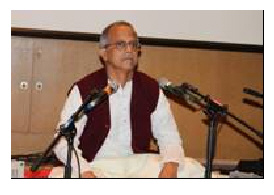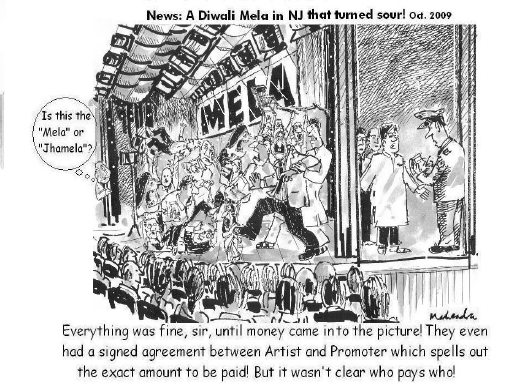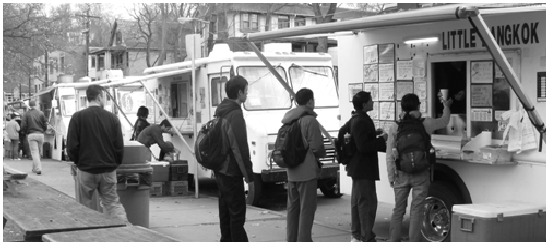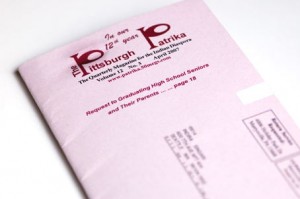Archive for March, 2010
A Mother’s Dream will continue….
Posted by admin in April 2018 on March 26, 2010
By Ameeta Ambe for Friends of Nandini, South Hills, Pittsburgh.
As many of you may know, Nandini Mandal – Principal and Artistic Director of Nandanik Dance Academy, in South Hills, Pittsburgh, has been going through a trying phase in her young life of thirty nine years since early 2009. She was diagnosed with Myelodysplastic Syndrome (MDS) in early 2009 which, progressed to Acute Myeloid Leukemia, a type of cancer, within a few months. With bone marrow transplant as her only alternative for a chance at recovery she spent some stressful months awaiting a bone marrow match.Â
Nandini put her dreams on hold while she courageously & admirably fought through the tribulation of finding a match & getting the transplant at NY’s Memorial Sloan Kettering Hospital.Â
Thanks to the generosity of one kind soul, an angel who, by donating the matching bone marrow made the difference of life to Nandini! Â She is now able to go back to dreaming of a life with her 2 beautiful young girls Roosha (11yrs) and Raka (3yrs), who need their mommy!Â
We request the readers of this story to take the first step of registering for a Bone Marrow donation. You could be the one saving a life too and making a difference to someone’s dreams. To get answers to any of your questions and concerns about Bone Marrow donation, visit www.marrow.org. Be an informed donor and hold the power to save a life.
After surgery at the Memorial Slaon Kittering Hospital in New York, Nandini stayed in New York at an interim housing provided by Hospital, trying to return to her independent self. In early March, Nandini returned to Pittsburgh in great spirits. Her further recovery will be overseen and followed up by transplant doctors at UPMC.Â
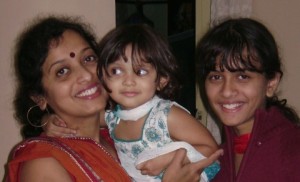 Nandini conveys her heartfelt thanks to the community in Pittsburgh and beyond who prayed for her well-being and speedy recovery in her trying time. Your blessings inspire Nandini to fight the fight of her life.Â
Nandini conveys her heartfelt thanks to the community in Pittsburgh and beyond who prayed for her well-being and speedy recovery in her trying time. Your blessings inspire Nandini to fight the fight of her life.Â
The website developed by her friends www.friendsofnandini.org, continues to update the community’s bighearted support not only financially but also through the volunteering efforts at the different events put forth by the Friends of Nandini.Â
We, the friends of Nandini profoundly thank all those who have come forward and helped us help Nandini and truly appreciate all your assistance in different areas. We extend our thanks to several local Indian restaurants & Indian stores that donated food, gifts as well as gift certificates towards making the Holiday India Fair/Indian mela held on Dec 5th 2009, a grand success. Helping someone in the time of need can be a joy – and we are gratified that several of us in Pittsburgh have come forward to do our best. We will keep you informed in the days ahead on our future activities and events.
Please see how you can continue to help… …
- To volunteer, email volunteer@FriendsOfNandini.org.
- Â To donate online, visit www.transplants.org search for Nandini Mandal.
- To donate by check, make check payable and mail to:
NFT Pennsylvania Bone Marrow Fund
5350 Poplar Avenue, Suite 430
Memphis, TN 38119
Please write ‘In honor of Nandini Mandal’ in the memo line.
Chhandayan’s Delightful Musical Evening
Posted by admin in April 2018 on March 26, 2010
By Samar K. Saha      e-mail: sksaha@uss.comÂ
The lovers of Hindustani Classical music were in for an autumn treat on the weekend of November 14, 2009. Chhandayan, with grant support from the Pennsylvania Council on the Arts, presented a memorable evening of Hindustani classical vocal music at the Graduate School of Public Health auditorium in Oakland. Â
The highlight of the show was a vocal presentation by Pt. Sandip Ghosh of Kolkata, well supported by Pt. Samir Chatterjee, Director of Chhandayan, on the tabla. Dipanjan Das of Pittsburgh provided the vocal and the harmonium support.Â
 His first presentation was a bara khayal in the raga Bihag. The gift of Sandip Ghosh’s melodious voice was detectable as soon as he started his Alap setting the listeners in a relaxed mood. As the presentation moved into jor, the serene and reposeful feeling of the raga was engulfing the whole auditorium. The Bandish Jiske Dil Par Gujri started in vilambit ektal with a romantic mood and this feeling kept on building up through swift, bold, and intricate tans as the tabla took the bandish into a higher tempo sitarkhani beat. Ghosh finished the raga in a tarana that was both mesmerizing and intoxicating. The standing ovation at the end was the singer’s reward for a well rendered presentation.Â
The listeners were in for more with his next piece – a chhota hhayal in raga Jog Kaus. Peeray Parai… was presented in a classic Kirana style. The finishing piece was “Mohe Lagi Lagan Guru Charanan Ki†— a bhajan in raga Shyam Kalyan in Teen Tal.
The other part of the evening presented at the beginning of the program was a jugalbandi – a vocal presentation by Nidrita Mitra Sinha of Pittsburgh and Soumya Chakraverty of Virginia on Sarod. Asish Sinha and Debupriya Nayak accompanied the artistes on the tabla.Â
We have heard jugalbandis before; but a vocal–sarod jugalbandi is uncommon. Such a performance demands a lot of versatility and virtuosity since the nature of human voice and a music instrument like Sarod and their scales are so different.Â
The artistes started with an early evening raga — Puriya Dhanashree with a slow meditative Alap moving onto Jor. The vilambit gat/bandish in addha tal  Mohe Lagi Lagan Guru Charanan Ki was finished with Shyam Shyam Ratata in drut teen tal. The duo presented their second composition – a bhajan in raga Desh in Dadra tal. The festive and joy-ous outburst of emotion of the raga poured out in this Shiva vandana Gale Bhujanga Bhashma Anga.
It was a courageous jugalbandi experiment. It would be an accomplishment if the artistes can carry this experiment to a level when the voice and the instrument fuse and merge with each other. The resonant tone of the Sarod was missing in this part of the show. It sounded too tinny. It was not clear if this was due to improper sound mixing or due to instrument tuning. Â
This scribe hated to see the evening end. His only regret was the poor turn up. Chhandayan should be hailed for bringing such an enjoyable program. Pittsburgh residents should be urged not to miss out on such a beautiful program. After all, the Indian classical music based on melody and rhythm is one of India’s biggest contributions to the world. n
West Bengal’s Jyoti Basu (1914 – 2010): In his long Marxist rule, parts of state withered away, literally!
Posted by admin in April 2018 on March 26, 2010
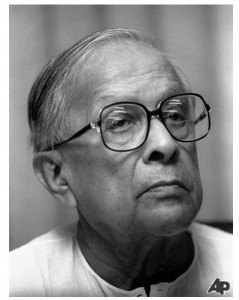 When Jyoti Basu, 95, the Marxist leader from West Bengal, died in January 2010, obituaries in leading English dailies — The Hindu, Hindustan Times, and Times of India and others — called him a colossus, a towering personality, pragmatist with a managerial style, and the prime minister India never had. UK’s Guardian admired his “tempered pragmatism.â€
When Jyoti Basu, 95, the Marxist leader from West Bengal, died in January 2010, obituaries in leading English dailies — The Hindu, Hindustan Times, and Times of India and others — called him a colossus, a towering personality, pragmatist with a managerial style, and the prime minister India never had. UK’s Guardian admired his “tempered pragmatism.â€
While the leading English dailies were praising him to the skies, they were rather muted in Basu’s failings. Hindustan Times’s writing was typical: “His tenure as chief minister was not without allegations of corruption, especially against his industrialist son. But these remained just allegations. While the agrarian reforms in West Bengal were hailed as a model across the country, Basu was widely faulted for his poor showing in various other sectors including industry, education and health.â€
Basu was West Bengal’s chief minister for 23 continuous years, a record unmatched in India, till he relinquished the job several years ago on account of senility.
While the Indian Media was praising Basu to the sky, the blogosphere and the comments underneath the obits were brutal in criticizing Jyoti Basu: “Jyoti Basu made West Bengal Waste Bengal,†“He died 30 years too late,†and “Thank god he did not become India’s prime minister. He would have made the whole of India a waste land.â€
It should be noted that in the period after India’s Independence in 1947, Calcutta (Kolkata now) and West Bengal were models for others to emulate in India. So, people participating in the blogosphere could be biased. Mostly they are the Bengali intelligentsia, its Bhadralok. Basu himself was paradoxically a Bhadralok, son of a doctor, and himself a barrister from England.
To have access to high-speed internet in India, you need to have some level of education and access to resources. So, I was looking for more objective measures on where West Bengal stands today, after over 30 years of proletarian Marxist rule with the “pragmatic manager†Jyoti Basu at the helm.
Here are the observations of Praful Bidwai, a Delhi-based peace activist and a left-of-center writer. Bidwai’s article under the caption “Jyoti Basu’s Mixed Legacy†was published on January 23, 2010 in the The international News www.thenews.com.pk).
- ˜ The percentage of rural households in India not getting enough food every day in some months of the year is highest in West Bengal (10.6%), worse than even Orissa (4.8%), perhaps India’s poorest state.
- West Bengal has more than 900,600 school dropouts in the 6-14 age group, higher than Bihar’s nearly 700,000.
- Of India’s 24 districts which have more than 50,000 out-of-school children, nine are in West Bengal.
- According to India’s Human Development Report (2004), in West Bengal, spending on, and access to, health services stagnated.
- Antenatal care, women’s nutrition, and doctors and hospital beds per 100,000 people in West Bengal are below national average.
- West Bengal hasn’t opened a new primary health centre in a decade.
- India’s worst recent food riots occurred in West Bengal when starving people raided the stores of corrupt ration-shop owners, all CPM members.
- Meanwhile, some of the gains of Basu-initiated land reforms have eroded: 17% of registered tenants have lost their land and another 27 percent are vulnerable.
- Under Basu’s Marxist rule, quality of higher education for which Bengal was famous, nosedived.
- Under Basu’s reign, his party cadres permeated all state bureaucracy and held sway, and he could not control or discipline them for their wayward behavior.
This is his “mixed†legacy. Even though this assessment will not be endorsed by all, a large section of educated Indians, and Bengalis in particular, believe that he was responsible for bringing down West Bengal to its knees, something even the British colonial power could not do.
Basu’s Marxist rule caused flights of educated people, capital and industries to the other states and sapped Bengal of its vitality. These Bengalis are not going to return to Bengal anytime soon.
His son Chandan Basu became an industrialist in Bengal when the state was under Marxist rule with the Marxist Jyoti Basu at the helm. Chandan Basu’s high-HP imported SUVs were confiscated for nonpayment of import duties. So much for Marxist proletarian ideology.
Basu’s spiritual mentor, China’s Deng Xiaopeng, abandoned Marxist ideas on production and distribution of goods and services and embraced what is now called “totalitarian capitalism.†But Basu saw no reason to change his strategy. So much for being “pragmatic manager.â€
English dailies even made a virtue of Basu’s atheism implicitly attributing it to his Marxist ideology. But atheism is not something that Indians had to learn from Marx, if only the anglicized Indian writers and editors  take their time to know India’s own philosophical traditions.
Marxist believe that in their Utopia, “state would wither away.â€Â In Basu’s Bengal, on many important measures the state indeed withered away. But the Marxists’ classless Utopia was nowhere in sight.   —  By Kollengode S. Venkataraman
Chennai Music Season
Posted by admin in April 2018 on March 26, 2010
Chennai Music Season Â
With a Few Apaswaras (off-key notes) Â
By Manjeri Raman, Savannah, GAÂ
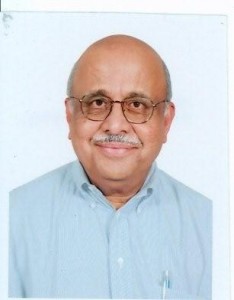 Manjeri Raman was a long-time resident of Robinson Twp. before he moved to Savannah, GA. Here are his observations on the last Chennai Music “Season.â€
Manjeri Raman was a long-time resident of Robinson Twp. before he moved to Savannah, GA. Here are his observations on the last Chennai Music “Season.â€
I moved to Chennai in March, 2009 for an one-year assignment with a chemical company. One of the attractions of the move was the famous annual music festival in the Tamil month of Marghazi (the solar month Dhanush) between mid December and mid January. The unofficial season starts in November itself with over sixty Sabhas (music associations) in the city organizing music concerts and dance recitals.
 This could very well be the world’s biggest music festival – over 4000 concerts in the greater Chennai metro area over eight weeks. Typical schedule at the most famous venue, the Madras Music Academy (The Academy for locals), has five concerts/day between 9:00 AM and 9:30 PM.
 The schedule follows a strict hierarchical grading of the performers. The prima donnas (male and female) get the evening prime-time slots with ticket prices steep by Indian standards. The aspirants get the rest of the slots with their own pecking order. Obviously, there is cut-throat competition to get on stage at the Academy and the successful people usually meet the basic standards. But connections, influences, recommendations, and local support also help! You can see varying shades of nepotism. Â
 A significant number of NRIs, particularly from the U.S., is in attendance with the books and other aids to understand the ragas and other nuances of Karnatic music. NRI artistes particularly from the US, Europe, and Singapore, taking advantage of the favorable exchange rates, have their own sabhas — Hamsadhwani and Musicians Living Abroad or MLA. Since it is not easy to get to go on stage in native sabhas, many of these NRI artistes perform in their own sabhas with other NRIs in the audience and later claim that their performance in Chennai was well-received by its discriminating and eclectic audience!
 Another strange trend, particularly in Bharatanatyam, and may be in other genre as well, is that often, the dancers pay the sabhas — and not the other way around — to get a chance to go on stage. Essentially, dancers with affluent parents/husbands, or their own resources pretty much buy their way to embellish their glitzy brochures.Â
 Locals complain that the NRIs garner the high-end tickets (inexpensive by the NRI standards) depriving the more dedicated Chennai music lovers affordable access. I had coffee one day and at my table were desis from California, Pennsylvania, New Jersey and Toronto!!
 I also met Mr. S. Raman, a retired government official from New Delhi who comes annually and attends only a selected number of concerts. He picks concerts with singers who he thinks perform according to the old Karnatic music traditions. He avoids the marquee crowd pullers. He also listens to young artists who get to sing for only ninety minutes. He was lamenting how the age-old Music Academy has changed for the worse with crass commercialism with sponsoring companies gaudily promoting everything under the sun in the premises!! Corporate logos as stage backdrops for saris, jewelry, hotels, and banks are jarring distractions.Â
 For many Chennai socialites, like socialites everywhere, attending concerts in the season is an annual ritual. Many women come in their best silks and diamonds. Often, they never miss an opportunity to engage in light conversations about the music just to make others aware that they are not totally ignorant!
 In the middle of a performance, sometimes, artistes greet the VVIPs arriving very late as they cavalierly glide into their front-row seats. This misbehavior both by the artistes and by the VVIPs galled me! Another bad, rude feature in Karnatic recitals is audience leaving the auditorium during the percussion solo (called tani avartanam). They return after a coffee or a bio-break. These “hoary†traditions continue.
 Now I want to vent my ire on the most obnoxious audience misbehavior. Unlike western concerts or operas where entry to the auditorium is limited to the breaks between acts or songs, the audience here can drift in and out as they please. We see this in the US too, to a lesser degree.
 For star performers, all seats are sold, and late comers’ empty seats are scattered throughout. Late comers for these seats drift in at their leisure right in the middle of the recital. It becomes an annoying experience to witness a parade of rear ends disturbing you as they walk in front of you. People walk in 90 minutes late for a 150-minute concert!!
 More than 50% of people leave the auditorium before the concert formally ends. They are usually in great hurry, and you need to be careful. You can be trampled! What amazes me is that the people who behave like this are the well educated and the well heeled!!
 There is no consideration to provide special facilities for handicapped people. In fact, there are many hazards for them to climb and cross hurdles to get to their seats right from the moment they enter the main gate.
 It is not unusual to see persons, particularly women, offering a loud greeting to someone sitting about three rows ahead of or behind them and enquiring about their welfare! I tried to enforce some discipline, most of the time failing in my attempt. Only genetic engineering offers hope.
 In spite of all this, I did enjoy the twenty-plus concerts, having learned to live through these aggravations.
Factoid in US-India History
Posted by admin in April 2018 on March 26, 2010
As an aside, this Church-initiated inquisition was the only religious persecution experienced by Jews within India, who migrated there after the destruction of their temple in the Siege of Jerusalem in the First Jewish-Roman War (70 CE).
After achieving independence in 1947, the Indian government started negotiations to take Goa back. The negotiations failed, which led to India’s successful armed action in 1961. The US reaction is worth noting: Adlai Stevenson, the US Ambassador to the UN at that time, condemned the Indian government action, and demanded that all Indian forces be unconditionally withdrawn from Goa!
Remember this the next time you hear the lyrics of the US national anthem, which, in the American context, rightly glorify the US defense of Fort McHenry against the British Royal Navy in the Chesapeake Bay.
For more reading, read: “Into the Mainstream,” by R. N. Saksena, Abhinav Publications (2003) ISBN: 81-7017-005-2
Bhangra in the Burgh Blasted the Cold Away !
Posted by admin in April 2018 on March 26, 2010
Bhangra in the Burgh Blasted the Cold Away
They also raised money for a Children’s Charity
As January 2010 unveiled, students returned to Oakland after the year-end holidays. The frigid days and deep-freeze nights made their life miserable in the campus. Understandably, if they sought some escapist entertainment, they didn’t have to go too far. It was right there in Oakland itself.Â
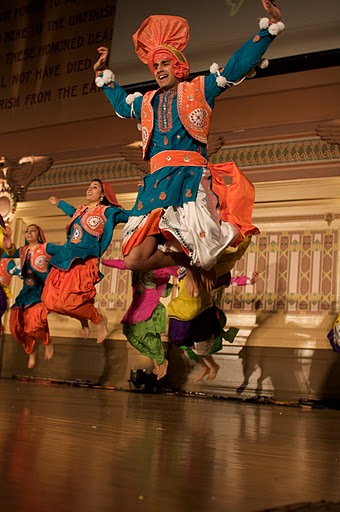 The 3rd annual Bhangra in the Burgh, held on Saturday, January 30 in Oakland despite the temperature in the teens, provided much-needed relief. Over 2500 people, mostly college students, both desi and non-desi and many older people converged at the cavernous Soldiers and Sailors Hall.
The 3rd annual Bhangra in the Burgh, held on Saturday, January 30 in Oakland despite the temperature in the teens, provided much-needed relief. Over 2500 people, mostly college students, both desi and non-desi and many older people converged at the cavernous Soldiers and Sailors Hall.
Around 150 participating students, equal numbers of boys and girls, came from eight neighboring universities — Drexel, Cornell, Rutgers, Virginia Commonwealth, Georgetown, George Mason, Univ. of Virginia, Univ. Michigan (Ann Arbor) and of course, the home team CMU, hosts for the evening. They were everywhere — in the lobby, on stage, off stage – decked out in the bright, shiny, and colorful Punjabi costumes.Â
The night provided raucous entertainment as an enthusiastic audience joined in the beats of songs rooted in Punjabi agrarian and rural ethos with liberal sprinkling of kudyan and munde (girls and boys) in the lyrics.
The energy of the dancers was unbelievable as they effortlessly defied gravity with their airborne jumps. One could burn calories simply watching these young men and women in flight in their dance routines.
At the end, Virginia Commonwealth U students were the winners.
CMU undergraduate students Gurmukh Singh Chhabra, Suraj Baxi, and Vishal Agrawal, organizers of the event, with help from several volunteers, raised over $14,000 through the sales of tickets and snacks. The money went this year to Children’s Home of Pittsburgh (www.childrenshomepgh.org). Subway, Bruegger Bagels, and Starbucks donated food for the participants’ green room. India Garden in Oakland provided samosas — a must for this event — at discounted rates to help them raise money.
When contacted, Gurmukh said, “I profusely thank the CMU’s Offices of the Students Affairs, Students Activities, and the Undergraduate Students Senate and the Executive Board of the Bhangra in the Burgh for making the event a great success. I also acknowledge CMU’s Jared Cohon’s interest in these activities.â€
If you haven’t experienced the energy of this annual event, you only have to wait until the next January.  Â
Participate in the Census 2010 Exercise
Posted by admin in April 2018 on March 26, 2010
In the early decennial censuses — the first one was in 1790 — the purpose was for apportioning the number of seats in the House of Representatives in the Congress for each state. It was, and still is, based on the state’s populations in relation to the whole nation’s population.
 Consider this: As a percentage of the nation’s population, Pennsylvania’s population has decreased from 6.9% in 1900 to 5.0% in 2000, to 4.1% in 2008. With the total number of House of Representatives in the US Congress held at 435, this has resulted fewer number of House members elected from Pennsylvania.
Consider this: As a percentage of the nation’s population, Pennsylvania’s population has decreased from 6.9% in 1900 to 5.0% in 2000, to 4.1% in 2008. With the total number of House of Representatives in the US Congress held at 435, this has resulted fewer number of House members elected from Pennsylvania.
Over the years, countless government agencies at the federal, state and local levels, nonprofits, and private businesses have come to rely heavily on the census data for their many decisions. For example, the federal gov-ernment annually distributes to states around $400 billion grant monies based on the states’ population demographics (number, age, gender, race, income/poverty data and others).
State/local governments use the same census data for drawing the boundaries of electoral districts, funding monies for libraries, building/widening roads and bridges and schools, mass transit decisions, and deploying ambulances, police cars and fire trucks for managing crises. Private businesses use the same census data for locating their offices, warehouses, hospitals, and developing product and marketing strategies… … …
This is where your participation in the US census becomes critical. This year, in March/April, all of you will receive a simple census form containing 10 easy questions. Please complete this form and mail it without any delay.
But there are more reasons why you should do it. At a personal level, being an very small ethnic minority, we need to know where we stand in the big picture of the region’s/nation’s demographics. Often, many of us have an exaggerated idea of our presence. More on this in a separate article in a future issue.
In the 2010 census, the US Census Bureau counts people tracing their heritage to India as a distinct group under the category Asian Indian.
If your roots are in India, remember to check the box against Asian Indian on Question 9 in the census form. Pakistanis, Bangladeshis, Nepalis and Sri Lankans need to check the box Other Asians and write their place of origin in the box.
An important point: When you fill out the census form, list all people living in your household irrespective of their legal status – citizens, immigrants, students from India, visitors, workers on H1B visa, or even undocumented people.
The census form does NOT ask information on the legal status of the person. The Census Bureau’s mandate is to take a snap shot on the head count and gather the statistics only around the number of people, their ages, and ethnicity. The Census Bureau does not and will not share personal details they collect with any other government agency.
As you see, census data is important in countless ways when dealing with federal, state and local governments, or other organizations. Completing the census form should take only ten minutes. Help yourself and your community by participating in this national exercise.
If we do not participate in the census due to negligence/lethargy, while all others participate, we won’t be counted. And we stand to lose big time as individuals, and also as a local community and citizens at large. So, our own self-interest also compels that we take this seriously.
Ha! and Hmmm…
Posted by admin in April 2018 on March 8, 2010
By Kollengode S. Venkataraman
Â
A florist goes for a haircut in Bangalore. When he goes to pay the barber, the barber says, “I cannot accept money from you; I am doing community service.” The next morning the barber finds some jasmine strands at his door. A fruit vendor goes for a haircut and the barber again refuses to take the money. A few days later, the barber finds a basket of seasonal fruits at his door.
On a Saturday a software guy goes for a haircut. The barber again refuses money saying it was a community service. The software engineer thinks, “Umm. Finally, these guys realize the importance of our work.”
The next Saturday when the barber goes to open his shop, he finds a bunch of software engineers waiting for a free haircut, with the printouts of forwarded e-mail of the free haircut.
Â
Late on a Saturday night, a Wisconsin woman called 911 to report a drunk driver — herself. In a recording of the call, the dispatcher is heard asking Mary Strey, 49, “You behind them?”
Strey answers, “No, I am them.” The confused dispatcher asks, “You am them?” “Yes, I am them.” The dispatcher then tells Strey to pull over so she doesn’t have an accident.
Strey was charged last week with driving drunk and operating a vehicle with a blood-alcohol level of 0.1 or more. Strey was heard on the call asking if she should turn the car off and put her hazard lights on.
Â
Note: This is not a fabrication. this is a true story.
Desis in National News
Posted by admin in April 2018 on March 8, 2010
By K.S. Venkataraman
Spanning three continents in his academic trajectory, Venkatraman Ramakrishnan at Cambridge University in England received the chemistry Nobel for 2009.
True desi ishtyle, soon after his getting the Nobel, according to the Press Trust of India, the Indian news organization, Ramakrishnan’s e-mail account for days was clogged with congratulatory messages from Indians making him spend over an hour to clear them. A disenchanted Ramakrishnan aired his frustration to PTI, “There are also people who have never bothered to be in touch with me for decades who suddenly feel the urge to connect. I find this strange.”
It is perfectly natural for people to have an urge to bask in the glory of others with whom they can identify in terms of faith, race, ethnicity, culture, nationalities, and languages: He/she is also a _______ just like me); or through universities, schools attended or memberships in exclusive clubs, especially if you can use it to your advantage (He/she is also a ________ alumnus or alumna like me) etc.
But then, we need to keep things in perspective. The following was attributed to Einstein:
In 1921, Albert Einstein presented a paper on his then-infant theory of relativity at the Sorbonne, the prestigious French university. “If I am proved correct,” he said, “the Germans will call me a German, the Swiss will call me a Swiss citizen, and the French will call me a citizen of the world. If relativity is proved wrong, the French will call me a Swiss, the Swiss will call me a German and the Germans will call me a Jew.”
If you have doubt, go and talk to the hedge-fund billionaire Raj Rajaratnam, another desi, who was in the news for entirely wrong reasons. Raj Rajaratnam, the founder of Galleon Group, was arrested last fall for alleged insider trading involving tens and tens of millions of dollars. His alleged desi accomplices are Rajiv Goel, an executive at Intel’s treasury department, and Anil Kumar, an executive at McKinsey & Company. In fairness to Rajaratnam, he also had other mainstream American accomplices as well.
I wonder, how many desis who were friendly with Rajaratnam on first name-basis in recent years would even acknowledge in public that Rajaratnam was their friends, or they were these his friends. Such is life. Life can be cruel.
End Note: Preet Bahara, another desi and the United States attorney for the Southern District of New York, is going after Rajaratnam. I am sure Bahara now has lots of friends. His social calendar will be overflowing during the holidays.
A Better Life
Posted by admin in January 2010 on March 4, 2010
By Rohit Dharawadkar
Attorney, Elliott & Davis, PC, Pittsburgh, PA
Phone: 412.434.4911 x. 28 /Email Rohit
 Rohit arrived in Pittsburgh in 2005 with a law degree from Southwestern University, Los Angeles, Calif. His specialty is immigration law which he has practiced for nine years. He lives in the South Hills.
Rohit arrived in Pittsburgh in 2005 with a law degree from Southwestern University, Los Angeles, Calif. His specialty is immigration law which he has practiced for nine years. He lives in the South Hills.
One of my earliest memories is standing underneath the staircase at my aunt’s house in Los Angeles, a few hours after arriving in the United States on a Pan Am flight from Bombay. Even then, at the age of five, I realized that my family had embarked on a great adventure, and I remember feeling very far away from what I had known to be my home. My family settled in the Los Angeles area, where I ended up attending school and college.
After completing college and graduating from law school, I began practicing immigration law in San Francisco in April 2001 and have been doing so ever since. Till then, I hadn’t considered exactly how my family had immigrated to the United States. As a child, I simply accepted that we were here, and as a teenager I swore the oath of allegiance to the US government without much thought.
Until that spring of 2001, as I began my practice as an immigration attorney, I had never really considered what it took for my parents to get me to this country. I eventually learned that my aunt had filed an immigrant visa petition on behalf of my mother, my father, my brother and me. An interview had taken place at a consulate in India, after which my entire family was granted Green Cards to enter and live in the United States. In 1980, the process took a total of five months.
Today, the beneficiary family in the same situation as my father would be waiting no less than 12-15 years for an approval. The processes and timings for immigration petitions have changed, but it appears, through all the clients I have helped, that the goals remain the same: a better life in the United States.
Just about every first or second generation child, in the re-telling of their parent’s immigration story, talks about how their parents came to the United States with around $300. For some reason every parent seems to have immigrated with only $300. These stories often conclude with the parents achieving the American dream. A few years back, I asked my father why he decided to leave his parents, extended family and friends, and move half way across the world to a place where he knew only five people — three of whom were children. Echoing the sentiments of all my immigration clients, his answer was simple: to make a better life for his family.
For most, the journey and the right to remain in the United States have become more lengthy and difficult. I am immensely satisfied to say that my life’s work has been to help individuals and families from around the world achieve their dream of coming to America, whether it’s applying for an H-1B visa after finishing graduate school, or navigating the sometimes treacherous path through the PERM employment-based labor certification process, or completing a filing for a mother or father who still lives back in the home country, I.
I recently received a post card at my office from a client whose wife had been granted a green card to the United States. It had a picture of the couple and a photo of her approved immigrant visa and simply read “Thank you very much Rohit for all your help.”
I have proudly hung the post card in my office as a reminder of why I do what I do, and the journey that my own family had taken to our life in the United States.
Delightful Street Foods of Bombay
Posted by admin in January 2010 on March 4, 2010
By Premlata Venkataraman
E-mail Premlata
Recently I read in the NYT that they have instituted awards for the superb street food collection that exists in New York. That brought memories of my Bombay days… … …
I was lucky I lived in Bombay which is a gastronomes’ delight for food from all regions of India. I am not talking of the trendy restaurants that litter all over the city today. I am referring to the street food culture in Bombay where you can get every meal from breakfast to late night snacks (even after watching the late-night “2nd show” crappy masala Hindi movie!)
And what an array there was… … You could have piping hot dosas with chutney & sambar, or with an egg fried on top. You could have the uniquely Bombay pav bhaji, the delicious and nutritious lunch of the rich and poor alike, served piping hot and spicy and, also hygienic because no germ would survive those volcanic temperatures.
You could have the real poor man’s snack vada pav at any time of the day and wash it down with a glass of water and call it a day. Of course the bhel puri/sev puri/dahi puri combos were ambrosia from heaven to stifle hunger pangs at any time of the day.
And pani puri, the snack that is a symbol of democracy and equality in eating.. Customers stand in a circle around the vendor as he plunges his thumb into the small 2″dia hollow puris to make a hole, fills the puris with spicy potato pieces, dunks the puri into sweet-and-tart jeera-tamarind water, and hands it over to his customers one by one. You put it into your mouth, and a rainbow of culinary experience explores in your mouth: As you bite into it, you find it is crispy, salty, cool, spicy hot, tart, sweet, with just enough liquid to smoothly swallow it down transporting you into a rapture of sorts to your taste buds… …
The New York Times story mentioned that Biryani Cart, won the People’s Taste Award at the Vendys second year in a row. They also commented that, “Their rice is a lot better than any of the other street carts. Most have plain old yellow rice. Theirs is actual biryani.”
Of course, in New York with its diverse multinational population, it is easy to have street food running the gamut from Japanese to Icelandic to Brazilian. (some more infor about the Vendys…)
Even after living in the suburbs for over 20 years, I have not lost my penchant for eating street food. Luckily I work in Oakland in a university, where we have several ethnic food “enclaves” – really they are street foods served from a truck — that serve the same delicious, hot, inexpensive fare for those days I do not pack a lunch. See above: Dining a la “Carts” at CMU. Inset: Saran from Thai Kitchen graciously serves food.
On the Outcome of Interfaith Gatherings
Posted by admin in January 2010 on March 4, 2010
By Kollengode S. Venkataraman
Interfaith dialog has been with us in this area for well over thirty years. A few Hindus and Sikhs, on their own personal initiatives, and decades before temples jumped into the bandwagon, met with mainstream Christian and Jewish groups during the year-end holiday season. After Nine-Eleven, interfaith dialog gained urgency, and officials from temples, gurudwaras and mosques all over the US have become proactive in organizing interfaith meetings in their places of worship.
In India, given its convulsive history in matters of religions and faith, live-and-let-live is the norm more-or-less, with no formal attempts for any faith-related dialog. This works for the most part until fresh inter- and intra-religious violence erupts, after which society adjusts itself to a new pseudo equilibrium. This cycle repeats itself over and over again.
Living in the U.S., I always wondered what the tangible outcome of these interfaith meetings is, given all the efforts that have gone into organizing these events, other than giving the representatives of the different faiths  face time to recognize that the fabric in America’s social-cultural-religious quilt is changing.
Representatives of the diverse faiths participating in interfaith meetings differ substantially on the matters of both body and spirit of the important underpinnings in their respective faiths. But when they share the stage and talk to each other on the effectiveness of the interfaith dialog, and address the general public, despite their theological differences, they will agree on their pessimistic and less than sanguine assessment of these meetings. But they can’t say it in public.
In this background, I read an article by Dr. Farish A. Noor, a Malaysian and a Senior Fellow at the S Rajaratnam School of International Studies, Nanyang Technological University, Singapore. He has spent over 15 years in interfaith dialog, and what he says is quite disheartening:
“I have been in this dialogue ‘business’ (and it is a business, mind you) for more than fifteen years now, with no tangible results, having attended more than fifty conferences, I have had the privilege of meeting the Pope, the Ayatollah of Iran, hundreds of prime ministers, presidents, ministers, deans, rectors, professors and public intellectuals; but with little to show for it. The inter-religious dialogue industry has become a law unto itself, driven by its own infernal logic and political economy that ultimately benefits only five-star hotels who… …host such events.”
He continues: “Everyone agrees that all religions preach peace and love, but as soon as they return they declare war on their neighbors. None of the sensitive, thorny issues — such as freedom of belief and conversion [coercive or enticed, we may add] is ever discussed, and all we have are platitudes and commonsensical bits of pedestrian wisdom dressed up as sound bites… [Meanwhile] age-old differences and prejudices remain intact and nobody really wants to be honest about our collective hypocrisy.”
He goes on: “[In these meetings, speakers] invariably frame inter-religious differences in terms of an oppositional dialectics where the Self [or one’s faith] is contrasted positively to the negative Other; and from these dialectical premises we are [expected] to reach a consensus and a great communal love-in. To expect such results from such flawed premises is silly to say the least, and waste of time and financial resources.”
In Pittsburgh I have attended a few interfaith gatherings myself, not as an organizer, but as a lay listener sitting in the audience. And I see Dr. Noor’s points. Several years ago I attended what was billed as an interfaith meeting at Carnegie Mellon University with a rabbi, pastor, priest, and maulvi, and two lay followers (one Hindu, and the other Zoroastrian) participating. As the meeting unfolded, it ended up with speakers scoring rhetorical points over each other’s faith. A few atheists in the audience derided everybody on the panel.
Often the formats of interfaith dialog are predisposed to failure simply because spiritual journey — the real purpose of all religions — is always arduous, painfully slow and solitary. Over 2500 years ago, it took several years for Siddhartha Gautama to become the Buddha. It is no different today. Decades ago, while in India, I remember reading about a few European Jesuit missionaries working in India for years, only to leave their order, becoming Vedantins.
This solitary spiritual journey, though mentally arduous, I must add, is rewarding in the end for individual Seekers of Truth. Siddhartha Gautama spent years before becoming the Buddha. So is the case with Vivekananda and Chinmayananda in our times, and others in every faith.
But when religions are organized with hierarchies, managing the temporal affairs of churches seriously erodes their legitimacy as we see repeatedly in all faiths, “Harvesting souls” — actually, it is increasing the market share — becomes an objective. “Harvesting souls” is how Pope Paul John II euphemistically put it during his visit in India in 2004 about hitting heard count targets in organized conversions.
Dr. Noor continues: “We talk of ‘bridge-builders’ …as if the inter-religious dialogue was already a contested territory … To even suggest that Is’am and the West require bridge-builders is to assume that there is a gulf between the two, and that this gulf has been there all along.”
But isn’t this the simple truth staring at all of us?
Again, Noor: “The fact is that both the Western and Muslim worlds share the same Abrahamic roots — and that both have been the oldest civilizational neighbors to each other. In our attempts to be politically correct and to recognize differences — we have invented divisions that were not there (or perhaps were not so pronounced in the past) and amplified them instead.. And instead of accepting that neither the Western nor Muslim worlds are homogeneous, we perpetuate the febrile fiction that the two are distinct and therefore need representation and representatives.”
Dr. Noor’s thesis that faiths that trace their tenets to a common root should not have so much strife contradicts what we see all around. The scriptures of the many faiths themselves and their dogma do not bear witness to this. Nor does the flow of world history. Read End of Faith by Sam Harris for details. Strangely, while Harris is harsh on organized religions, he himself is a seeker of personal spiritual growth.
On the basis of Dr. Noor’s thesis, how do rationalize the following?
- The strife between Jews and early Christians that persisted through two millennia leading to the Inquisition and persecutions?
- The strife between the Vatican and the Eastern traditions of Christianity, namely, Russian, Greek, Syrian traditions?
- The clash between the Catholics and the Protestants in Europe since the time of Martin Luther and the birth of the Anglican Church? Read Ross Douthat’s article “Benedict’s Gambit” in New York Times on Pope Benedict’s overture to the Anglicans to stem the rise of Islam in Europe.
- North American Evangelicals and Charismatics raiding the flock of traditional Catholics in Latin America?
- The divisions between Shias and Sunnis soon after the death of Prophet Mohammed? And Shias and Sunnis together not recognizing Ahmedias as Muslims, considering them apostates?
The scene in India is similar, but not anywhere as violent I must emphasize, as among the Abrahamic religions in Europe and the Middle East.
- So was the case with Hinayana (Theravada) and Mahayana Buddhism at the peak of their influence in India. Ironically, Buddhism, by far the most practical and nondogmatic religion, could not avoid getting enmeshed in dogma after the Buddha’s time. Incidentally, Hinayana (literally, smaller or weaker vehicle) is a pejorative phrase coined by Mahayanis. Theravada (or the Path of the Elders) is how Hinayana is now called.
- Among Jains, Digambars and Shvetambars have had strong differences, though not violent, thanks to the Jains’ commitment to ahimsa.
- Hindus have had their differences with the Buddhists and Jains, some of whose outcomes were not very pleasant, to say the least.
- Among Hindus, the Advaitins, Saivites, and Vaishnavites differ on theology, dogma and rituals, which has manifested in silly, laughable ways. The caste differences among them add another layer to the complexity.
- And Vaishavites among themselves have problems too. In India, the two branches of Tamil Vaishnavites — Vada-kalai and Then-kalai, literally Northern and Southern Schools — went all the way up to the Indian Supreme Court. Why? To resolve whose naamam (the religious mark in vermillion and white clay powder traditional Vaishnavites wear on their forehead) can be put on the forehead of the elephant in the Vaishnavite temple in Kanchipuram. (Note for the uninitiated: The naamam of the two sects differ slightly that outsiders may not be able to notice at all.)
Coming in this tradition of theological nitpicking, Indian communists with their allegiance to Russia have had problems over doctrine with Indian Marxists whose inspiration in China, similar to religious orthodoxies. Recently, Indian Marxists vowed to annihilate Maoist in Central India.
Human institutions are like living organisms. They grow, bifurcate or trifurcate, become weak, die and become extinct, or morph and evolve. And man’s instinct to influence, control and dominate others, and others’ instinct to resist, are visceral that bring out the animals in human beings. However, highlighting the differences in the arcane nitpickings in dogma and theology give man a patina of intellectual sophistication for his instinct to control and dominate. Of course, when intellectual persuasion fails, inducements and brute force are always there.
I think the driving force for much of the religious strife is as much biological as it is theological; driven as much, if not more, by man’s hormones as by his intellect. I use masculine pronouns deliberately. Without sounding sexist, why is that through history, the leaderships in religious and political strife have been overwhelmingly male? ♠

